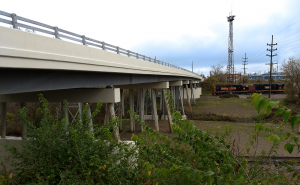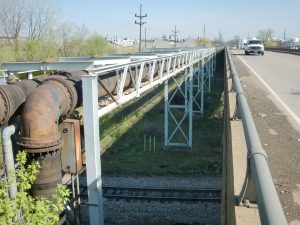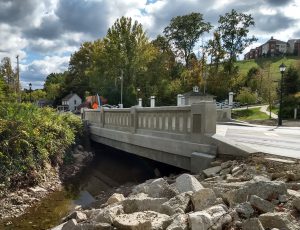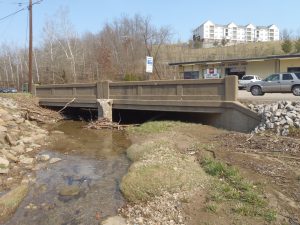
Pennoni is excited to announce both our Richland Avenue over Coates Run and Gambrinus Avenue Bridge Rehabilitation projects have been selected for an Honor Award in the ACEC Ohio 2021 Engineering Excellence Awards.
The Engineering Excellence Awards Competition is an annual program that brings well-deserved public recognition to Ohio’s engineering industry by spotlighting engineering projects that demonstrate a high degree of uniqueness, ingenuity, and value. A four-member panel of professional engineers/surveyors judged 30 entries submitted in the 21st annual competition. Projects are rated based on uniqueness and originality; technical value to the engineering profession; social and economic considerations; complexity; and how successfully the project met the needs, including time and budget constraints, of the client.
Gambrinus Avenue Bridge Rehabilitation
 Pennoni provided the engineering study, design, and plan preparation for the rehabilitation of the 458‐ft long Gambrinus Avenue Bridge in Canton Township, Stark County, OH, which was originally constructed in 1962 and was in poor condition. The seven span bridge crosses over Hurford Run and active railroad tracks owned by Wheeling & Lake Erie Railway (WLER) that service the adjacent Timken Steel complex and other industrial sites.
Pennoni provided the engineering study, design, and plan preparation for the rehabilitation of the 458‐ft long Gambrinus Avenue Bridge in Canton Township, Stark County, OH, which was originally constructed in 1962 and was in poor condition. The seven span bridge crosses over Hurford Run and active railroad tracks owned by Wheeling & Lake Erie Railway (WLER) that service the adjacent Timken Steel complex and other industrial sites.
The rehabilitation included a deck replacement, pier cap replacement, new galvanized steel beams, expansion joint replacement, approach pavement, and guardrail replacement as well as extensive substructure repairs. Unique to the bridge was the use of 14-inch fluted cast-in-place reinforced concrete piles which were produced locally in Canton. The substructure also incorporated seven 35 ft. tall pile-bent piers.
 Additionally, WLER maintains an active rail yard just east of the crossing, so close coordination was a top priority during design and construction on this federally funded project. To be compliant with FRA Track Safety Standards, crash walls were incorporated into those pier bents adjacent to the tracks.
Additionally, WLER maintains an active rail yard just east of the crossing, so close coordination was a top priority during design and construction on this federally funded project. To be compliant with FRA Track Safety Standards, crash walls were incorporated into those pier bents adjacent to the tracks.
While the contractor was excavating for the crash wall barriers, it was noticed that the existing pier bents had started to settle. An investigation revealed that the existing piling was not driven to an appropriate depth. With the contractor on hold, Pennoni analyzed the existing pile capacity, designed new piles and foundations to supplement the existing foundations, and prepared plan details in 45 days. The solution incorporated new piles and foundation into the existing pile bent, which limited the extra cost and time delays that the County would have incurred with new piers.
Once the pier issue was resolved, the construction continued with new pile caps, setting the galvanized steel beams, and pouring the reinforced concrete deck. The bridge opened to traffic in the Spring of 2020.
Richland Avenue over Coates Run

The City of Athens engaged Pennoni to design the replacement or rehabilitation of the structurally deficient bridge carrying Richland Avenue over Coates Run in the business district south of Ohio University. The existing bridge was a two span, 20-ft. concrete slab bridge, built in 1927, on full height abutments and pier. Because of the past development along Richland Avenue and Coates Run, one of the challenges faced by the design team was the periodic flooding on Richland Avenue at the bridge site.
Pennoni was tasked with studying the stream hydraulics to provide solutions to mitigate the flooding problem. One of the issues found was that up to six feet of sediment had been deposited within the channel. While recommendations to specifically address the hydraulic issues were included in the report, completion of those tasks were deferred due to funding issues.
Pennoni’s preliminary structural investigation showed that while the slabs comprising the bridge deck were in satisfactory condition, the pier was in poor condition. Pennoni’s calculations showed that it was not feasible to obtain the loading necessary for rehabilitation to be an option.
With the debris caught by the pier contributing to the flooding problem, and the poor condition of the pier and poor soil conditions found at its footing elevations, the City requested that the pier be removed in the new design, if feasible.
Pennoni’s solution was a single span cast-in-place reinforced concrete slab, specifically designed to match the thickness of the existing slab to address the flooding concerns. Galvanized reinforcing steel was incorporated into the structure to extend the life of the new bridge, and the railing was modified to create a period railing which aesthetically matches other bridges in the Athens area.
The new bridge was built using part-width construction to accommodate activity in the business district, allowing access to local retailers and the adjacent apartment complexes.